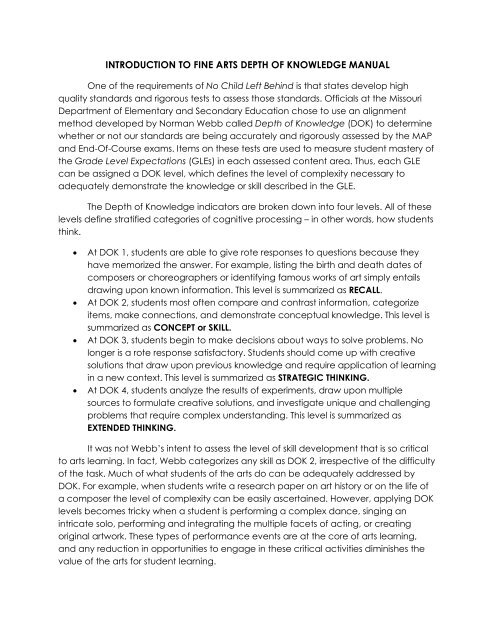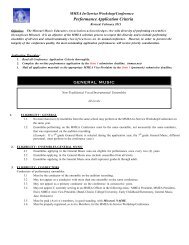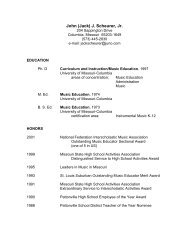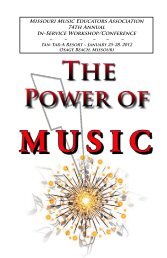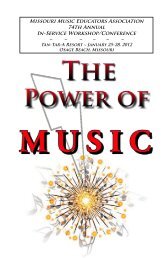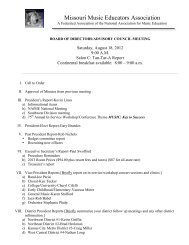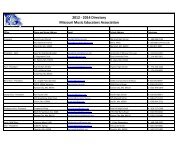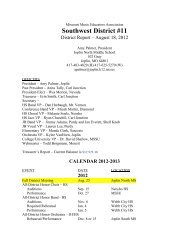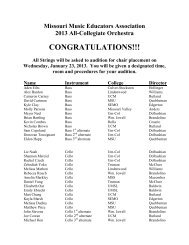introduction to fine arts depth of knowledge manual - Missouri Music ...
introduction to fine arts depth of knowledge manual - Missouri Music ...
introduction to fine arts depth of knowledge manual - Missouri Music ...
You also want an ePaper? Increase the reach of your titles
YUMPU automatically turns print PDFs into web optimized ePapers that Google loves.
INTRODUCTION TO FINE ARTS DEPTH OF KNOWLEDGE MANUAL<br />
One <strong>of</strong> the requirements <strong>of</strong> No Child Left Behind is that states develop high<br />
quality standards and rigorous tests <strong>to</strong> assess those standards. Officials at the <strong>Missouri</strong><br />
Department <strong>of</strong> Elementary and Secondary Education chose <strong>to</strong> use an alignment<br />
method developed by Norman Webb called Depth <strong>of</strong> Knowledge (DOK) <strong>to</strong> determine<br />
whether or not our standards are being accurately and rigorously assessed by the MAP<br />
and End-Of-Course exams. Items on these tests are used <strong>to</strong> measure student mastery <strong>of</strong><br />
the Grade Level Expectations (GLEs) in each assessed content area. Thus, each GLE<br />
can be assigned a DOK level, which de<strong>fine</strong>s the level <strong>of</strong> complexity necessary <strong>to</strong><br />
adequately demonstrate the <strong>knowledge</strong> or skill described in the GLE.<br />
The Depth <strong>of</strong> Knowledge indica<strong>to</strong>rs are broken down in<strong>to</strong> four levels. All <strong>of</strong> these<br />
levels de<strong>fine</strong> stratified categories <strong>of</strong> cognitive processing – in other words, how students<br />
think.<br />
• At DOK 1, students are able <strong>to</strong> give rote responses <strong>to</strong> questions because they<br />
have memorized the answer. For example, listing the birth and death dates <strong>of</strong><br />
composers or choreographers or identifying famous works <strong>of</strong> art simply entails<br />
drawing upon known information. This level is summarized as RECALL.<br />
• At DOK 2, students most <strong>of</strong>ten compare and contrast information, categorize<br />
items, make connections, and demonstrate conceptual <strong>knowledge</strong>. This level is<br />
summarized as CONCEPT or SKILL.<br />
• At DOK 3, students begin <strong>to</strong> make decisions about ways <strong>to</strong> solve problems. No<br />
longer is a rote response satisfac<strong>to</strong>ry. Students should come up with creative<br />
solutions that draw upon previous <strong>knowledge</strong> and require application <strong>of</strong> learning<br />
in a new context. This level is summarized as STRATEGIC THINKING.<br />
• At DOK 4, students analyze the results <strong>of</strong> experiments, draw upon multiple<br />
sources <strong>to</strong> formulate creative solutions, and investigate unique and challenging<br />
problems that require complex understanding. This level is summarized as<br />
EXTENDED THINKING.<br />
It was not Webb’s intent <strong>to</strong> assess the level <strong>of</strong> skill development that is so critical<br />
<strong>to</strong> <strong>arts</strong> learning. In fact, Webb categorizes any skill as DOK 2, irrespective <strong>of</strong> the difficulty<br />
<strong>of</strong> the task. Much <strong>of</strong> what students <strong>of</strong> the <strong>arts</strong> do can be adequately addressed by<br />
DOK. For example, when students write a research paper on art his<strong>to</strong>ry or on the life <strong>of</strong><br />
a composer the level <strong>of</strong> complexity can be easily ascertained. However, applying DOK<br />
levels becomes tricky when a student is performing a complex dance, singing an<br />
intricate solo, performing and integrating the multiple facets <strong>of</strong> acting, or creating<br />
original artwork. These types <strong>of</strong> performance events are at the core <strong>of</strong> <strong>arts</strong> learning,<br />
and any reduction in opportunities <strong>to</strong> engage in these critical activities diminishes the<br />
value <strong>of</strong> the <strong>arts</strong> for student learning.
It is clear how <strong>to</strong> apply DOK levels <strong>to</strong> written work, even in the <strong>arts</strong>. Our challenge<br />
in the <strong>arts</strong> is <strong>to</strong> identify activities and behaviors that appropriately demonstrate higher<br />
levels <strong>of</strong> thinking through performance or production <strong>of</strong> <strong>fine</strong> art. For example, music<br />
students can demonstrate understanding <strong>of</strong> the concept <strong>of</strong> rhythm by either (1) writing<br />
the counting under a rhythmic pattern, or (2) accurately performing that rhythm. The<br />
first task clearly requires an understanding <strong>of</strong> the concept <strong>of</strong> rhythm, but the second<br />
goes a step further by demanding performance <strong>of</strong> that rhythm, a skill that necessitates<br />
decoding <strong>of</strong> the rhythmic pattern combined with technical <strong>knowledge</strong> and the<br />
physical response related <strong>to</strong> either singing or instrumental performance. Both methods<br />
communicate understanding <strong>of</strong> the concept, but the second values the actual<br />
performance, and is in fact a better indica<strong>to</strong>r <strong>of</strong> mastery. In theatre, students can write<br />
a comprehensive study <strong>of</strong> a play as a completely valid measure <strong>of</strong> understanding (DOK<br />
4). But if the intent is <strong>to</strong> utilize higher order thinking skills, draw upon multiple resources<br />
over time, and come up with a new and creative solution <strong>to</strong> understanding the<br />
underlying themes and messages <strong>of</strong> the work, would not an inspired performance <strong>of</strong> a<br />
monologue from the play also give the artist-performer a valid vehicle for<br />
demonstrating understanding? The goal is <strong>to</strong> value the performance or production <strong>of</strong><br />
art as a meaningful indica<strong>to</strong>r <strong>of</strong> deep understanding and thinking.<br />
The aim <strong>of</strong> encouraging students <strong>to</strong> engage in higher levels <strong>of</strong> cognitive<br />
processing can be accomplished in many ways. There is no better way <strong>to</strong> “spark”<br />
higher order thinking than through the <strong>arts</strong>. Rather than reducing the time students<br />
spend in the <strong>arts</strong>, schools should embrace the <strong>arts</strong> as a way <strong>to</strong> nurture creative<br />
problem-solving skills that are so critical <strong>to</strong> success in <strong>to</strong>day’s workplace. On the pages<br />
that follow, teachers, administra<strong>to</strong>rs, parents and students can learn ways <strong>to</strong> use<br />
dance, visual art, music and theatre <strong>to</strong> demonstrate complex reasoning in the<br />
classroom through the performance or production <strong>of</strong> <strong>fine</strong> art.<br />
FINE ARTS DOK COMMITTEE<br />
Steve Williams, Chair<br />
Fine Arts Consultant<br />
<strong>Missouri</strong> Department <strong>of</strong> Elementary and<br />
Secondary Education<br />
Cheryl Venet, Visual Art<br />
Rockwood School District<br />
Aurelia Hartenberger, <strong>Music</strong><br />
Lindbergh School District<br />
Debbie Corbin, Theatre<br />
Branson School District<br />
Marla Drewel-Lynch, Dance<br />
Kirkwood School District<br />
Paul Morales, <strong>Music</strong><br />
Lee’s Summit School District<br />
Sharyn Hyatt-Wade, Visual Art<br />
Columbia School District
Ed Hanson, <strong>Music</strong><br />
Columbia School District (ret.)<br />
Jennifer Forest-James, Theatre<br />
Parkway School District<br />
Ken Franke, Theatre<br />
Hazelwood School District<br />
Rheba Vetter, Dance<br />
Northwest <strong>Missouri</strong> State University<br />
Linda Lange, Visual Art<br />
Francis Howell School District


